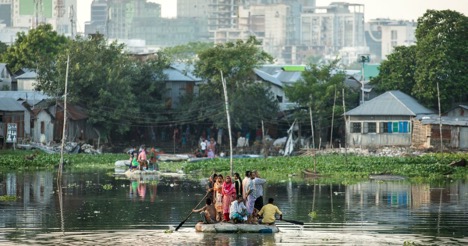 ‘Climate change is the most severe problem that we face today – more serious even than the threat of terrorism’ writes David King, former Chief Scientific Advisor of the United Kingdom.
‘Climate change is the most severe problem that we face today – more serious even than the threat of terrorism’ writes David King, former Chief Scientific Advisor of the United Kingdom.
The ties between climate change and population migration are not new. The first warning sign can be traced to the 1990s, when the Intergovernmental Panel on Climate Change in its first United Nations Environmental report on climate change stated, ‘The gravest effects of climate change may be those on human migration, as millions will be displaced. Within few years, the accuracy of this prediction was proven, as about 25 million people were displaced from their homes. India’s next-door neighbour, Bangladesh has vulnerable geography which is highly susceptible to natural disasters and rising sea levels. By 2050, one in every seven people in Bangladesh will be estimatedly displaced due to climate change. Therefore, the human security of Bangladeshi migrants will be increasingly compromised as inadequate refugee shelters will amplify vulnerabilities. Moreover, India would be immediately threatened by migrants moving to neighbouring countries to reduce further losses.
One of the major reasons for this issue to be brought to the forefront is, that even after 35 years of coining the term “environmental refugee”, there is no official definition for it, which then could have formed the basis of their protection and rehabilitation. The absence of any definition or recognition for these climate-induced migrants makes it quite impossible to bring them under the law and help them. Deliberate efforts are being made to provide recognition to climate-induced migrants/refugees in the 1951 Refugee Convention. The instability of the status of the climate-induced displaced people until now and no access to financial grants, food aids, shelter, education, social identity, makes this a deep-rooted problem. The vast scale of climate displacement, coupled with the lack of legal framework, calls for innovative techniques to mitigate the plight of climate migrants. India and Bangladesh need to adopt a regional approach to combat climate change, manage migration and analyse conflict dynamics.
At a policy level, a participatory approach to address the wide-reaching impacts of climate change is the need of the hour. Integrating diplomatic, development, humanitarian, and security tools in a multivector approach with investment in climate mitigation would be crucial. This would be the first step in building the capacities needed to effectively address the myriad risks that climate change poses. There is a need for international recognition of the problem, a better understanding of its consequences and a willingness to tackle it. This is no longer an environmental problem, nor a narrow national security issue! Climate change is a collective security threat in a hyper globalized world order infused with ceaseless migration, fragility and interdependence. We have to keep in mind that this climate-induced migration will continue to happen and potentially result in violent conflict. The sooner we acknowledge the inevitability of this movement, the sooner we will be able to cope with it.

